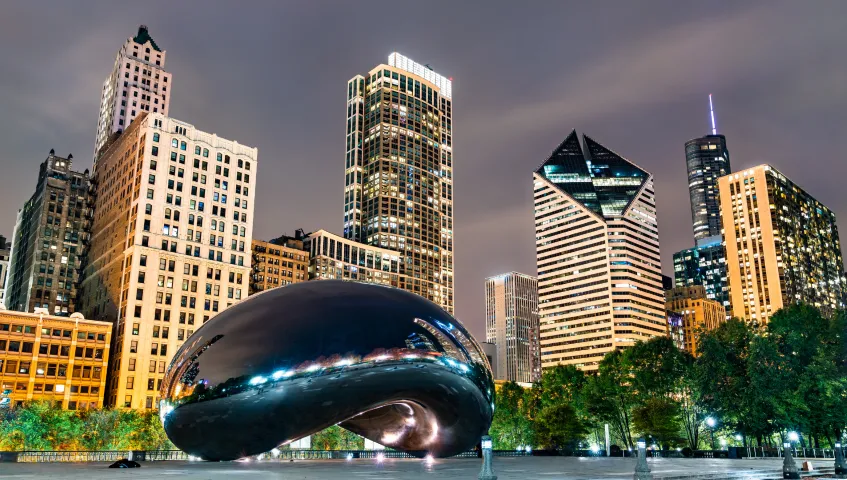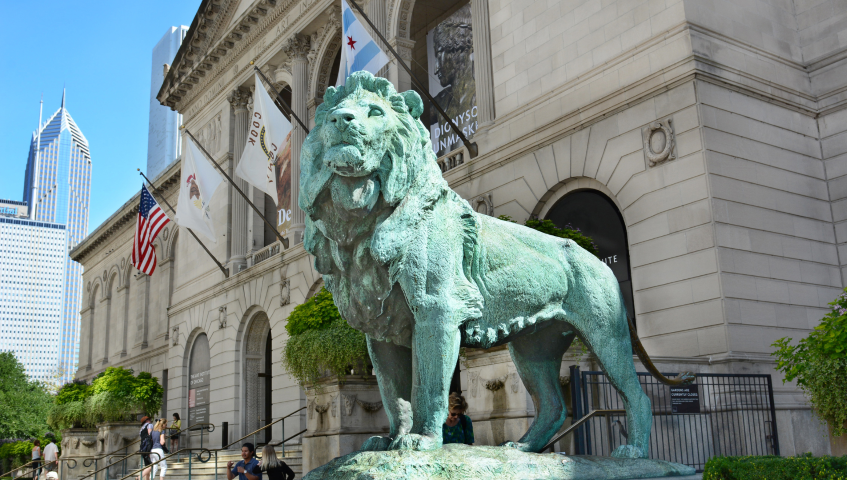Chicago is back in a big way. After the quiet years of the pandemic, the Windy City welcomed more than 55 million visitors in 2024, nearly reaching its pre-2019 highs.
If you’ve been waiting for a sign to book a trip, this is it. Chicago is buzzing — with theater, music, food, festivals, and, of course, that polarizing yet irresistible deep-dish pizza.
But what do you actually do here? Beyond staring at the skyline and singing along to “Go Cubs, Go,” how do you spend your days?
Consider this your talkative travel buddy’s guide — the kind of friend who texts restaurant recs at midnight and drags you to photo spots just when the light is perfect.
Let’s dive into the best of Chicago, broken down into experiences you’ll actually want to live, not just tick off a list.
✈️ Pro tip: Before we dive in, check out how to find the best flight deals with Skyscanner — it’ll save you serious cash for those deep-dish indulgences.
Sailing and Spinning at Navy Pier
Chicago’s lakefront jewel is Navy Pier, a lively mix of carnival rides, boat tours, and skyline views that deserve their own postcard.
The Centennial Wheel is the star here, rising almost 200 feet and giving you that iconic lake-to-skyline panorama without splurging on a helicopter ride.
It’s open almost year-round, but summer nights are the magic hour: the Ferris wheel glowing, the lake breeze cooling you down, and fireworks sparkling above twice a week.
Admission to the pier itself won’t cost you a dime, though rides and cruises add up. Expect around twenty dollars for the wheel and thirty to sixty for a boat cruise that whisks you across Lake Michigan.
If you’re hungry, resist the lure of chain restaurants; instead, try Giordano’s on the pier for a slice of tourist-famous deep-dish — it’s cliché, but it hits the spot after a long stroll.
Two or three hours are plenty if you’re just browsing, but give it half a day if you’re adding a show, cruise, or fireworks to the mix.
🎟️ Skip-the-line tickets and tours here: Viator Navy Pier Experiences
Mingling at Millennium Park
No trip to Chicago feels complete without a pilgrimage to Millennium Park. Of course, there’s the Bean — officially Cloud Gate — gleaming like liquid metal and reflecting the entire skyline in a funhouse mirror.
But Millennium Park is so much more than one selfie. It’s the city’s cultural square, hosting symphony concerts at the Pritzker Pavilion, yoga classes on the grass, ice skating in winter, and pop-up art installations that change with the seasons.
The park opens bright and early at six in the morning and stays alive until eleven at night. It’s free to wander, which makes it an easy stop no matter your budget.
The smart move? Go early in the morning if you want that coveted solo Bean photo, because by mid-morning, you’ll be elbowing for space with a dozen other tourists holding selfie sticks.
Summer is prime time for music and food festivals, while winter turns the space into a snow-dusted skating rink. One to two hours is enough for casual sightseeing, but plan for longer if you stumble onto a festival or decide to linger for a concert.
🌍 Looking for inspiration beyond the U.S.? Compare this with my San Francisco travel blog – my first visit.
Cruising the Chicago Riverwalk
If Millennium Park is Chicago’s cultural heart, then the Riverwalk is its social living room. Stretching along the Chicago River, this pedestrian path buzzes with joggers, artists, pop-up bars, and visitors taking in the way the city’s architecture literally leans over the water.
It’s a great place to wander with a coffee or glass of wine in hand, but if you want the full story behind those towers, hop on an architecture cruise. You’ll learn how the Great Fire of 1871 sparked a wave of bold rebuilding that shaped the skyline we know today.
Strolling the Riverwalk is free, and a casual walk might only take an hour, but the real treat is adding in a boat or kayak.
Cruises average around thirty to sixty dollars, while kayaks run twenty to thirty per hour for a more active adventure.
I’m partial to sunset tours — the glass buildings glow pink and gold as the sun dips, and suddenly you understand why Chicagoans love their skyline so much. If hunger strikes, stop at City Winery for riverside bites and wine, or grab a scoop from the walk-up ice cream counters that dot the path.
🚤 Book your Chicago River architecture cruise on Viator
Wandering the Art Institute of Chicago
Even if you’re not an art buff, the Art Institute of Chicago has a way of winning you over. This is where Van Gogh’s self-portraits hang, Monet’s water lilies bloom on canvas, and Georgia O’Keeffe’s desert landscapes transport you far beyond Illinois.
Fans of Ferris Bueller’s Day Off will recognize the museum instantly — that dreamy museum sequence was filmed right here.
General admission runs just over thirty dollars, and the museum stays open from late morning until early evening, with extended hours on Thursdays.
It’s tempting to try and see everything in one visit, but the smarter strategy is to pick a wing or two — maybe the Impressionists, maybe the Modern Wing — and give yourself space to actually soak it in.
The café here is surprisingly solid, with fresh salads and sandwiches if you need a break. Two to four hours is realistic, but if you’re the type to read every placard, you could easily spend the whole day.
Shopping the Magnificent Mile
Michigan Avenue’s Magnificent Mile is part retail therapy, part architectural showcase.
You’ve got designer stores, department giants, hotels that gleam with old-school glamour, and historic icons like the Chicago Water Tower, one of the few buildings to survive the Great Fire.
Whether you’re chasing fashion finds or just love the buzz of a busy avenue, it’s worth a wander.
Stores here generally run ten to eight, but the real charm isn’t in rushing from shop to shop — it’s in the people-watching, the occasional street performer, and the chance to duck into gems like Eataly for espresso and gelato breaks.
You’ll want at least two or three hours, more if your credit card is itching.
Cheering at Wrigley Field
Wrigley Field is hallowed ground, even if you couldn’t tell a fastball from a curveball. The ivy-covered outfield, the hand-turned scoreboard, the fans belting out “Take Me Out to the Ball Game” — it’s all part of baseball history.
On game day, the entire Wrigleyville neighborhood seems to pulse with energy, spilling out into bars long after the last pitch.
Tickets start around thirty dollars but climb higher for big matchups. If baseball isn’t your thing, tours of the ballpark run year-round and offer a behind-the-scenes peek into locker rooms, press boxes, and the quirky traditions that make Wrigley, well, Wrigley.
Expect to spend three or four hours for a game or an hour for a tour, but don’t be surprised if you stick around longer — the vibe is infectious.
⚾ Book ballpark tours or Cubs tickets easily on Trip.com.
Applauding at the Chicago Theatre
The glowing marquee of the Chicago Theatre is one of the city’s most recognizable symbols, and stepping inside is like entering a gilded palace.
Velvet seats, ornate chandeliers, ceilings that look like they belong in a European opera house — and that’s before the curtain even rises. The programming swings from Broadway tours to comedy legends to concerts, so there’s almost always something to catch.
Tickets vary by show, but whatever you see, plan to arrive early enough to wander the lobby and snap a photo under the marquee outside.
Pairing this with a night at Second City for comedy is a move I always recommend. All in, you’re looking at two or three hours, depending on the show’s length.
Playing at Maggie Daley Park
Right beside Millennium Park lies Maggie Daley Park, which feels like it was designed by someone who believes adulthood shouldn’t mean giving up playground fun.
There are whimsical climbing walls, a winding ice-skating ribbon in winter, crazy themed play structures for kids, and even a mini-golf course.
Families adore it, but I’ll tell you, I’ve seen plenty of adults happily swing or skate without kids in tow.
Entry is free, but activities like mini-golf and skate rentals add modest fees. Summer weekends can get packed, so a weekday visit makes it easier to find a shady picnic spot. In winter, buy your skating tickets online in advance to skip the long lines.
Plan for two or three hours if you’re here for activities, or a quick hour if you’re just wandering through.
Biking the Elevated 606 Trail
Chicago’s answer to New York’s High Line, the 606 is a 2.7-mile elevated trail built on old rail lines, weaving through neighborhoods like Wicker Park and Logan Square.
Murals brighten the walls, greenery frames the path, and the skyline peeks through just when you least expect it. It’s a more local vibe than the Riverwalk, but just as enjoyable.
The trail is free, and Divvy bikes can be rented nearby for just a few dollars. Ride at sunset, when the city glows and the pace slows down.
The beauty of the 606 is that it connects you right into foodie neighborhoods, so you can hop off for tacos, craft coffee, or a brewery stop before riding on. One to two hours is enough, but with snack breaks, you might find yourself stretching it longer.
🚲 Bike rentals? Try booking via Trip.com car & gear rentals.
Roaming Lincoln Park Zoo
Few things in life are free these days, but Lincoln Park Zoo proudly remains one of the last free zoos in the country. Set right in the heart of the city, it’s home to lions, gorillas, penguins, and more, with the added bonus of an adjoining conservatory filled with lush greenery.
The zoo opens mid-morning and closes around five, with extended hours in summer. Admission is free, though special encounters cost extra. Pair a zoo visit with a walk to nearby North Avenue Beach, and you’ll have a day that feels equal parts urban and seaside escape.
Expect to spend two or three hours wandering, though with kids or animal lovers, it could easily stretch to half a day.
Quick Planning Advice
Chicago shifts with the seasons. Summer brings festivals, rooftop bars, and lake breezes, while fall is crisp, golden, and less crowded. Winter has a magical holiday charm if you’re bundled properly, and spring bursts with tulips in Millennium Park.
Three days will cover the highlights, but five to seven give you room to explore neighborhoods like Pilsen, Logan Square, or Hyde Park.
Getting around is easy without a car. The CTA “L” trains and buses are affordable and reliable, downtown is highly walkable, and rideshares fill the gaps.
Budget about a hundred to two hundred dollars per day for a mid-range trip, not counting splurges like theater tickets or fine dining.
💡 If you’re dreaming beyond Chicago, peek at my Italy budget travel guide for inspiration.

